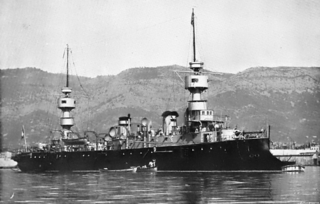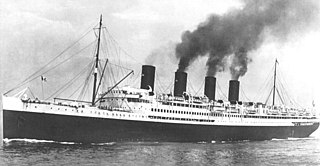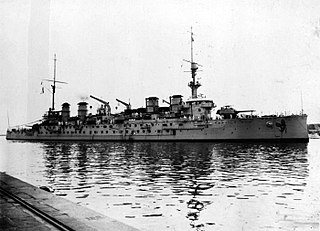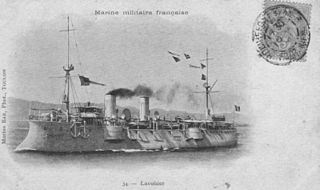 W
WAmiral Charner was an armored cruiser built for the French Navy in the 1890s, the name ship of her class. She spent most of her career in the Mediterranean, although she was sent to China during the Boxer Rebellion of 1900–01. The ship was assigned to the International Squadron off the island of Crete during 1897-1898 revolt there and the Greco-Turkish War of 1897 to protect French interests and citizens. Amiral Charner spent most of the first decade of the 20th century as a training ship or in reserve. The ship was recommissioned when World War I began in 1914 and escorted convoys for several months before she was assigned to the Eastern Mediterranean to blockade the Ottoman-controlled coast. During this time, she helped to rescue several thousand Armenians from Syria during the Armenian genocide of 1915. Amiral Charner was sunk in early 1916 by a German submarine, with only a single survivor rescued.
 W
WThe Amiral Charner class was a group of four armoured cruisers built for the French Navy during the 1890s. They were designed to be smaller and cheaper than the preceding design while also serving as commerce raiders in times of war. Three of the ships were assigned to the International Squadron off the island of Crete during the 1897–1898 uprising there and the Greco-Turkish War of 1897 to protect French interests and citizens. With several exceptions the sister ships spent most of the first decade of the 20th century serving as training ships or in reserve. Bruix aided survivors of the devastating eruption of Mount Pelée on the island of Martinique in 1902. Chanzy was transferred to French Indochina in 1906 and ran aground off the Chinese coast in mid-1907. She proved impossible to refloat and was destroyed in place.
 W
WBruix was one of four Amiral Charner-class armored cruisers built for the French Navy in the 1890s. She served in the Atlantic Ocean, the Mediterranean, and in the Far East before World War I. In 1902 she aided survivors of the devastating eruption of Mount Pelée on the island of Martinique and spent several years as guardship at Crete, protecting French interests in the region in the early 1910s.
 W
WChâteaurenault was a large protected cruiser built for the French Navy in the late 1890s and early 1900s. She was intended to serve as a long-range commerce raider, designed according to the theories of the Jeune École, which favored a strategy of attacking Britain's extensive merchant shipping network instead of engaging in an expensive naval arms race with the Royal Navy. As such, Châteaurenault was built with a relatively light armament of just eight medium-caliber guns, but was given a long cruising range and the appearance of a large passenger liner, which would help her to evade detection while raiding merchant shipping.
 W
WThe D'Assas class comprised three protected cruisers of the French Navy built in the early 1890s; the ships were D'Assas, Cassard, and Du Chayla. They were ordered as part of a naval construction program directed at France's rivals, Italy and Germany, particularly after Italy made progress in modernizing its own fleet. The plan was also intended to remedy a deficiency in cruisers that had been revealed during training exercises in the 1880s. As such, the D'Assas-class cruisers were intended to operate as fleet scouts and in the French colonial empire. The ships were armed with a main battery of six 164 mm (6.5 in) guns supported by four 100 mm (3.9 in) guns and they had a top speed of 20 knots.
 W
WThe French cruiser Desaix was one of three Dupleix-class armored cruisers built for the French Navy in the first decade of the 20th century. Designed for overseas service and armed with eight 164.7-millimeter (6.5 in) guns, the ships were smaller and less powerfully armed than their predecessors. Completed in 1904, Desaix was initially assigned to the Mediterranean Squadron before she was transferred to the Atlantic Division the following year, where she served as a flagship. The cruiser returned to the Mediterranean in 1906, but only remained there for a year before rejoining the Atlantic Division. Desaix was in reserve from 1909 to 1914.
 W
WThe Descartes class comprised two protected cruisers of the French Navy built in the early 1890s; the two ships were Descartes and Pascal. They were ordered as part of a naval construction program directed at France's rivals, Italy and Germany, particularly after Italy made progress in modernizing its own fleet. The plan was also intended to remedy a deficiency in cruisers that had been revealed during training exercises in the 1880s. As such, the Descartes-class cruisers were intended to operate as fleet scouts and in the French colonial empire. The ships were armed with a main battery of four 164 mm (6.5 in) guns supported by ten 100 mm (3.9 in) guns and they had a top speed of 19.5 knots.
 W
WD'Estrées was the lead ship of her class of protected cruisers built for the French Navy in the late 1890s. The class was ordered as part of a construction program directed at strengthening the fleet's cruiser force at a time the country was concerned with the growing naval threat of the Italian and German fleets, and were intended to serve overseas in the French colonial empire. D'Estrées was armed with a main battery of two 138 mm (5.4 in) guns, was protected by an armor deck that was 38 to 43 mm thick, and was capable of steaming at a top speed of up to 20 to 20.5 knots.
 W
WDupetit-Thouars was a Gueydon-class armoured cruiser of the French Navy. She was torpedoed and sunk on 7 August 1918 by SM U-62 with the loss of 13 of her crew.
 W
WThe French cruiser Dupleix was the lead ship of her class of three armored cruisers built for the French Navy in the first decade of the 20th century. Designed for overseas service and armed with eight 164.7-millimeter (6.5 in) guns, the ships were smaller and less powerfully armed than their predecessors. Completed in 1903, Dupleix was initially assigned to the Atlantic Division as its flagship. The ship spent 1906 to 1909 in reserve before she was sent to the Far East in 1910, again serving as a flagship.
 W
WThe Dupleix class consisted of three armored cruisers built for the French Navy at the beginning of the 20th century. Designed for overseas service and armed with eight 164.7-millimeter (6.5 in) guns, the three ships of the class were smaller and less powerfully armed than their predecessors.
 W
WEdgar Quinet was an armored cruiser of the French Navy, the lead ship of her class. She and her sister ship, Waldeck-Rousseau, were the last class of armored cruiser to be built by the French Navy. Edgar Quinet was laid down in November 1905, launched in September 1907, and completed in January 1911. Armed with a main battery of fourteen 194-millimeter (7.6 in) guns, she was more powerful than most other armored cruisers, but she had entered service more than two years after the first battlecruiser—HMS Invincible—had rendered armored cruisers obsolescent.
 W
WErnest Renan was an armored cruiser built for the French Navy in the first decade of the 20th century. At the outbreak of World War I in August 1914, she participated in the hunt for the German battlecruiser SMS Goeben and then joined the blockade of the Austro-Hungarian Navy in the Adriatic. She took part in the Battle of Antivari later in August, and the seizure of Corfu in January 1916, but saw no further action during the war. After the war, the British and French intervened in the Russian Civil War; this included a major naval deployment to the Black Sea, which included Ernest Renan. She served as a training ship in the late 1920s before she was sunk as a target ship in the 1930s.
 W
WSS France was a French ocean liner which sailed for the Compagnie Générale Transatlantique, colloquially known as CGT or the "French Line". She was later nicknamed "Versailles of the Atlantic", a reference to her décor which reflected the famous palace outside Paris. Ordered in 1908, she was introduced into the Transatlantic route in April 1912, just a week after the sinking of RMS Titanic, and was the only French liner among the famous four-funnel liners. France quickly became one of the most popular ships in the Atlantic. Serving as a hospital ship during World War I, France would have a career spanning two decades. Her overall success encouraged CGT to create even larger liners in the future.
 W
WThe Friant class comprised three protected cruisers of the French Navy built in the early 1890s; the three ships were Friant, Bugeaud, and Chasseloup-Laubat. They were ordered as part of a naval construction program directed at France's rivals, Italy and Germany, particularly after Italy made progress in modernizing its own fleet. The plan was also intended to remedy a deficiency in cruisers that had been revealed during training exercises in the 1880s. As such, the Friant-class cruisers were intended to operate as fleet scouts and in the French colonial empire. The ships were armed with a main battery of six 164 mm (6.5 in) guns supported by four 100 mm (3.9 in) guns and they had a top speed of 18.7 knots.
 W
WThe French cruiser Gueydon was the name ship of her class of armoured cruisers built for the French Navy in the 1890s.
 W
WJeanne d'Arc was an armoured cruiser built for the French Navy at the end of the 19th century, the sole ship of her class. Completed in 1903, she was initially assigned to the Northern Squadron, although she was transferred to the reserve fleet before the end of the year. The ship was recommissioned for a few months in mid-1905 and was transferred to the Mediterranean Fleet in mid-1906 and served as a flagship for the next several years. Jeanne d'Arc was assigned to the reserve in mid-1908 and modified to serve as a training ship for naval cadets of the Naval Academy. In 1912, she made the first of two lengthy training cruises.
 W
WJules Ferry was the second of three Léon Gambetta-class armored cruisers built for the French Navy during the first decade of the 20th century. Armed with four 194-millimetre (7.6 in) guns, the ships were much larger and more powerfully armed than their predecessors. Completed in 1907, she was assigned to the Mediterranean Squadron where she served as a flagship.
 W
WJules Michelet was an armoured cruiser of the French Navy, laid down in 1904 and completed in 1908. It was a development of the Léon Gambetta class of armoured cruisers, and was the sole representative of its type. It served during the First World War being eventually sunk as a target in 1937.
 W
WKléber was one of three Dupleix-class armored cruisers built for the French Navy in the first decade of the 20th century. Designed for overseas service and armed with eight 164.7-millimeter (6.5 in) guns, the ships were smaller and less powerfully armed than their predecessors. Completed in 1904, Kléber was initially assigned to the Mediterranean Squadron before she was transferred to the Atlantic Division three years later, where she often served as a flagship. The ship was reduced to reserve in 1909–1910 before she was sent to the Far East in 1911. Kléber returned to France two years later and was again placed in reserve.
 W
WLatouche-Tréville was one of four Amiral Charner-class armored cruisers built for the French Navy in the 1890s. The ship spent the bulk of her career in the Mediterranean and was assigned to the International Squadron off the island of Crete during the 1897–1898 upring there and the Greco-Turkish War of 1897 to protect French interests and citizens. Latouche-Tréville spent most of the first decade of the 20th century as a training ship or in reserve. The ship was recommissioned before World War I began in 1914, and escorted convoys for several months before she was assigned to the eastern Mediterranean to support Allied operations and bombard the Ottoman-controlled coast. She was lightly damaged in 1915 by an Ottoman shell while providing naval gunfire support during the Gallipoli Campaign. Latouche-Tréville became a training ship in late 1917 and was decommissioned in 1919. She was stricken from the navy list the following year and was sold for scrap in 1926.
 W
WLavoisier was a protected cruiser of the French Navy built in the 1890s, the third and final member of the Linois class. Ordered as part of a large construction program aimed at countering the fleets of France's rivals, the Linois class was intended for use with France's fleets in home waters and in the French colonial empire. Lavoisier was armed with a main battery of four 138.6 mm (5.5 in) guns, was protected by an armor deck that was 40 mm (1.6 in) thick and she had a top speed of 20.5 knots.
 W
WLéon Gambetta was the lead ship of her class of three armored cruisers built for the French Navy in the first decade of the 20th century. Armed with four 194-millimeter (7.6 in) guns, the ships were much larger and more powerfully armed than their predecessors. Completed in 1905, she was initially assigned to the Northern Squadron where she served as a flagship. The ship was transferred to the Mediterranean Squadron in 1910 and remained there for the rest of her career.
 W
WMontcalm was a Gueydon-class armoured cruiser built for the French Navy in the 1890s. The ship saw service during World War I in the Pacific. Following the war, Montcalm was used as an accommodation ship. In 1934, the vessel was renamed Trémintin and was sunk during World War II by British aircraft.
 W
WThe French cruiser Pothuau was an armoured cruiser built for the French Navy in the 1890s. She spent most of her active career in the Mediterranean before becoming a gunnery training ship in 1906. The ship participated in the Kamerun Campaign early in World War I before she was transferred to the Red Sea and the Indian Ocean in 1916 where she patrolled and escorted convoys. Pothuau fruitlessly searched the Indian Ocean for the German commerce raider Wolf in mid-1917. The ship resumed her previous role after the war until she was decommissioned in 1926 and sold for scrap three years later.
 W
WWaldeck-Rousseau was an armored cruiser built for the French Navy in the first decade of the 20th century. She was the second and final member of the Edgar Quinet class, the last class of armored cruiser to be built by the French Navy. She was laid down at the Arsenal de Lorient in June 1906, launched in March 1908, and commissioned in August 1911. Armed with a main battery of fourteen 194-millimeter (7.6 in) guns, she was more powerful than most other armored cruisers, but she had entered service more than two years after the first battlecruiser—HMS Invincible—had rendered the armored cruiser obsolescent. Waldeck-Rousseau nevertheless proved to be a workhorse of the French Mediterranean Fleet.